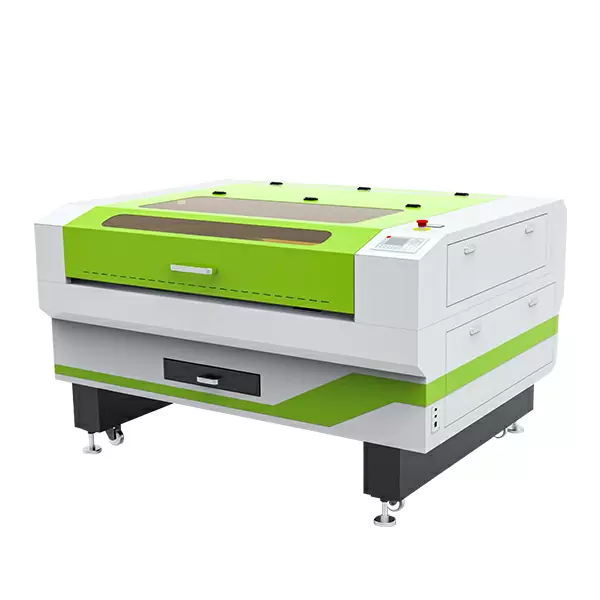The cooling system in a CO2 laser engraving machine plays a crucial role in maintaining optimal operating conditions and directly impacts its efficiency in several ways:
- Laser Tube Temperature Control: CO2 lasers generate significant heat during operation. The cooling system helps regulate the temperature of the laser tube, preventing overheating. Stable tube temperatures ensure consistent laser performance and longevity.
- Heat Dissipation: The cooling system removes excess heat generated by the laser tube and other components, preventing overheating of critical parts and maintaining operational stability.
- Maintaining Optimal Performance: Laser efficiency can degrade at higher temperatures. An efficient cooling system helps maintain the laser’s efficiency by keeping it within the optimal temperature range, ensuring consistent engraving quality.
- Preventing Component Damage: Excessive heat can damage sensitive components, such as optics, mirrors, and electronic parts. A properly functioning cooling system prevents such damage, reducing the need for repairs and downtime.
- Reducing Downtime: Efficient cooling systems help minimize the risk of overheating-related breakdowns, contributing to increased machine uptime and productivity.
- Enhanced Laser Tube Lifespan: Cooling systems prolong the lifespan of the laser tube by preventing thermal stress and extending the tube’s operational life, reducing the frequency of costly tube replacements.
- Consistency in Engraving Quality: Stable temperatures contribute to consistent laser performance, ensuring uniform engraving quality across different materials and projects.
- Energy Efficiency: Efficient cooling systems consume less energy while effectively managing heat dissipation, contributing to overall energy efficiency in the operation of the laser engraving machine.
In summary, a well-designed and properly maintained cooling system is essential for maintaining stable operating temperatures, preserving component integrity, extending the lifespan of critical parts, and ensuring consistent, high-quality engraving performance in CO2 laser engraving machines.
What limitations or challenges exist in co2 laser engraving machine technology?
While CO2 laser engraving machines offer numerous benefits, they also face certain limitations and challenges:
- Material Compatibility: CO2 lasers are highly efficient with non-metallic materials like wood, acrylic, and plastics. However, their effectiveness with some metals is limited. Direct metal engraving requires specific CO2 laser setups or additional processes like coatings.
- Depth Control: Achieving precise and consistent depth control can be challenging, especially on certain materials. Ensuring uniform engraving depth across different materials and thicknesses might require adjustments in power, co2 laser engraving machine speed, and focus, posing challenges for intricate designs.
- Heat-Affected Zone (HAZ): CO2 lasers can generate heat, leading to a heat-affected zone around the engraving area, especially on materials like wood. This zone may cause discoloration or changes in material properties near the engraved region.
- Reflective Materials: Reflective or metallic surfaces can reflect the laser beam, potentially damaging the machine’s optics or reducing engraving effectiveness. Coating or masking may be required to prevent reflections.
- Maintenance Requirements: CO2 laser machines have components like mirrors, lenses, and tubes that require regular maintenance and cleaning to maintain optimal performance. Neglecting maintenance can lead to decreased efficiency and increased downtime.
- Initial Cost: High-quality CO2 laser engraving machines can be expensive to purchase and install. This initial investment might pose a challenge for smaller businesses or startups.
- Engraving Speed: While CO2 lasers offer high precision, achieving high speeds without compromising accuracy can be challenging, particularly for complex or detailed designs.
- Safety Concerns: CO2 lasers emit invisible infrared radiation, necessitating strict safety measures and proper training for operators to prevent accidental exposure or eye damage.
- Environmental Impact: Some materials used in the engraving process, especially certain plastics or coatings, may produce fumes or gases that require proper ventilation or filtration, posing environmental challenges.
- Regulatory Compliance: Compliance with safety regulations, especially regarding laser usage, requires adherence to strict guidelines, adding complexities and considerations in the operation of CO2 laser engraving machines.
Addressing these challenges often involves advancements in technology, continuous innovation, proper training for operators, material research, and adherence to safety standards to optimize the efficiency and effectiveness of CO2 laser engraving machines.
